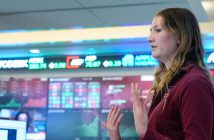The United States economy is not likely headed for another recession, but sustained slow growth could fundamentally alter the American Dream, a panel of economic experts said on Feb. 1.
The nation’s 2012 economic forecast calls for about 2 percent growth, said Distinguished Professor of Economics Dominick Salvatore, Ph.D. That simply isn’t enough to put six million Americans who have lost jobs since the 2008 recession back to work, he said at an economics roundtable sponsored by the Graduate School of Arts and Sciences.

Dominick Salvatore, Ph.D. Photo by Chris Taggart
“The U.S. has done everything possible to overcome the crisis,” he said. “Interest rates are low and we have provided liquidity. In our fiscal policy, we’ve taken on incredible budget deficits in a non-war period—this is the most powerful expansionary fiscal policy since 1946.
“Still, we have not grown.”
Salvatore and a panel of Fordham alumni working in the economic sector were largely in agreement on the causes of U.S. woes: outsourcing of jobs, unsustainable deficit and public debt, too much economic uncertainty for investors, an undervalued Chinese Yuan, and a looming European debt crisis.
Mary Ann Bartels, GSB ’85, GSAS ’92, managing director and head of U.S. Technical and Market Analysis Global Research at Merrill Lynch, said that the nation is undergoing a “deleveraging” process in the banking, consumer and government sectors. The financial sector is still broken from the housing bubble and will most likely take about six years to clear the supply in order to bring demand back.
“When we look at forecasting the economy at my firm, the word we use is ‘muddle through,’” she said.
Furthermore, she said, the resulting structural unemployment could have long-lasting effects on how Americans view opportunity and the hope for a better life.
“The problem of unemployment is not with the latter ages, it is with our youth who are graduating and can’t find jobs—that unemployment rate is 25 to 30 percent,” she said. “That is the part of the population you really want to get employed.”

L to R, Higgins, Bartels, Quinlan and Salvatore.
China may be a sleeping giant with manipulated currency, but it is not attracting the foreign direct investment that the United States does, said Joseph P. Quinlan, GSAS ’84, managing director and chief market strategist for Bank of America Capital Management.
In 2011, Quinlan said, the U.S. attracted $213 billion in foreign investment—twice the amount of China—largely because the U.S. is a much more consumption-driven economy than China is and is more protective of intellectual property, among other reasons.
“I wish the president would talk about insourcing instead of outsourcing,” he said. “Bring [more]foreign companies here. It creates jobs.”
For investors, emerging markets—those where the ratio of debt to GDP is low at approximately 30 percent—will offer some long-term growth opportunity, said Thomas D. Higgins, Ph.D., GSAS ’02, global macro strategist and senior vice president of Standish BNY Mellon.
“But you have to be willing to ride the wave,” he said. “Because there will be volatility until the advanced economies have managed to get back to where they are no longer carrying unsustainable debt.” Currently, the U.S. debt exceeds 100 percent of its GDP.
Salvatore said that his family brought him to the United States when he was young for a better life. He reflected on the fate of today’s young Americans, who are facing mountains of debt, slow economic growth, and double-digit unemployment.
“For me, this was a country of opportunity, of education, and of dreams,” he said. “If young people today can’t (even) find a job, there will be crisis of hope.”


